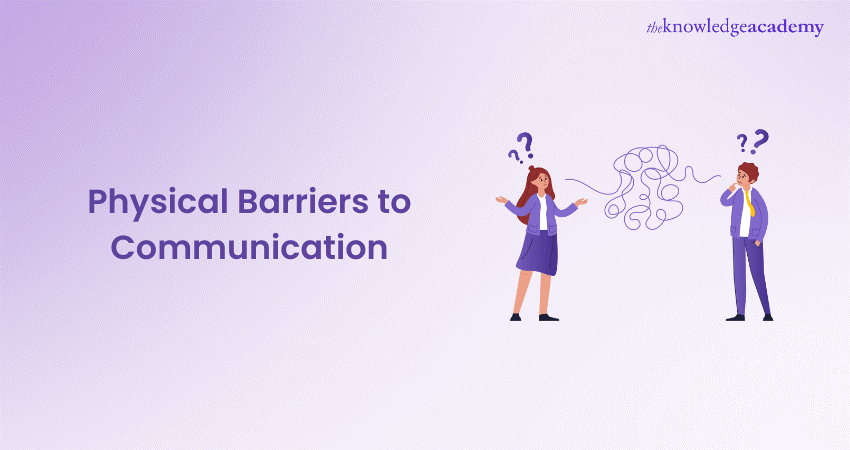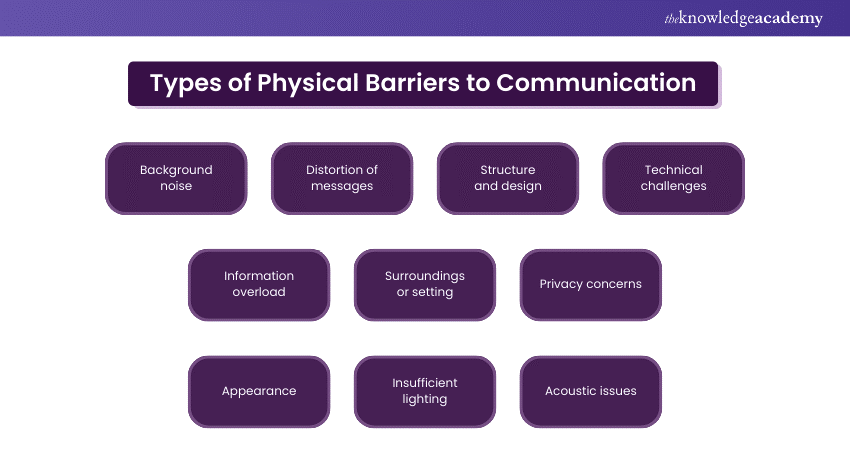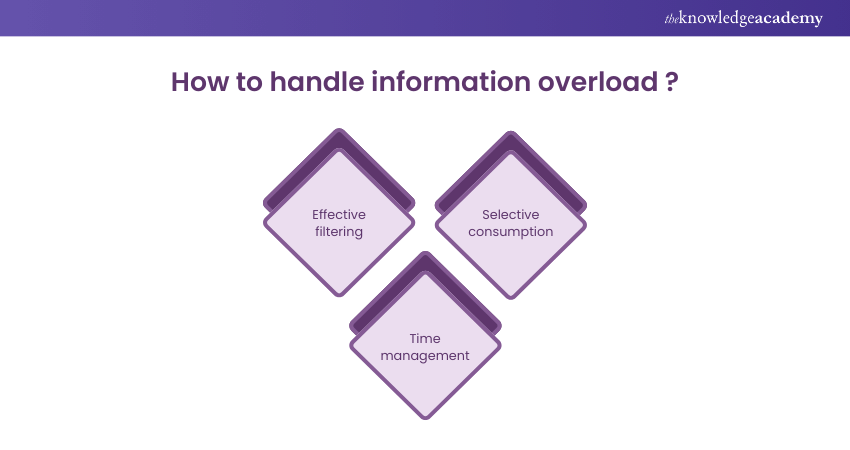We may not have the course you’re looking for. If you enquire or give us a call on +971 8000311193 and speak to our training experts, we may still be able to help with your training requirements.
Training Outcomes Within Your Budget!
We ensure quality, budget-alignment, and timely delivery by our expert instructors.

Imagine we’re all painters, but instead of brushes, we use words to create our pictures. What if our canvas had bumps or our studio was too noisy? These are the Physical Barriers to Communication that sneak into our conversations. They’re like pesky flies that buzz around, making it hard to focus on painting our masterpiece of dialogue.
By understanding and managing these barriers, we can set up the perfect studio for our words to paint clear and beautiful pictures. This blog will explore Physical Barriers to Communication in detail and the way to overcome these obstacles.
Table of Contents
1) What are Physical Barriers to Communication?
2) 11 Physical Barriers to Communication
a) Background noise
b) Distortion of messages
c) Structure and design
d) Technical challenges
e) Information overload
f) Surroundings or setting
g) Privacy concerns
h) Appearance
i) Insufficient lighting
j) Acoustic issues
k) Physical discomfort
3) Conclusion
What are Physical Barriers to Communication?
A Physical Barrier in Communication is an environmental or tangible obstacle that hinders the transmission of messages between individuals. These barriers can be as varied as noise pollution, distance, poor network connections, or even walls and closed doors. They disturb the flow of verbal and nonverbal Communication by causing messages to be unexpressed or unheard.
For instance, a bulldozer can abruptly interrupt a conversation, or a bad arrangement of workplace layout prevents colleagues from getting connected. However, overcoming these barriers may demand tactful strategic planning, which could include soundproofing, effective use of technology or redesigning space to enhance Communication flow. Identifying and getting rid of Physical Barriers is a key factor in having clear, effective exchanges between people both in personal and professional environments.
11 Physical Barriers to Communication
Communication is the bridge that binds people together, ensuring that thoughts, feelings, and information are shared. When this bridge is sturdy, relationships flourish, businesses thrive, and understanding deepens.
However, the consequences can be significant when barriers obstruct this bridge. Misunderstandings may arise, projects can falter, and connections may weaken. Let's examine these barriers and how to overcome them.

Background noise
Background noise is one of the most common Physical Barriers to effective Communication. It may be any disturbing sound that obstructs the intended audio message. This could include an air conditioner's humming, car noises from outside, nearby conversations, and even electronic devices whirring. This often leads to the message being misunderstood or lost in its entirety because the receiver may fail to hear and comprehend it.
Ways to overcome:
Conquering background noise is possible only by controlling the environment. This might involve:
a) Choosing the right environment: Selecting a quiet place for important conversations or meetings.
b) Using technology: Employing noise-cancelling headphones or microphones during virtual meetings or when working in noisy areas.
c) Soundproofing: Using sound-absorbing materials in the design of spaces where such clear Communication is vital, such as boardrooms or offices.
d) Timing: Scheduling discussions or meetings when there is less activity and noise.
Unlock the power of effective Communication with our Effective Communication Skills Training - sign up now.
Distortion of messages
Distorting messages plays a leading role in confusing messages; frequently, it results in misunderstandings and even conflicts. It occurs when the original message sent by the sender is altered, intentionally or unintentionally, before it reaches the receiver. This transformation can be observed for several reasons, which include semantic barriers, where particular terms have different meanings among different people; selective perception, where the receiver perceives what they want to see; or due to the influence of emotions and cultural differences. Distortions can also occur in non-verbal Communication through misinterpreted gestures or expressions.
Ways to overcome:
Effective strategies to reduce message distortion include:
a) Clear Communication: Use simple, clear language, avoiding jargon and complex terminology. Be specific rather than general to prevent ambiguity.
b) Active listening: Encourage active listening, where the listener pays full attention, asks for clarification, and provides feedback, ensuring that the message is received as intended.
c) Cultural sensitivity: Be aware of and sensitive to cultural differences that may affect interpretation. Tailor your Communication to accommodate these differences.
d) Emotional awareness: Recognise and control emotional responses that may affect how messages are sent, received, and interpreted.
Structure and design
The structure and design of Communication channels heavily affect the efficiency and clarity of the Communication process. In an organisational setting, such complex hierarchies and bureaucracy can hamper the flow of information and make it distorted. On the other hand, Communication without a coherent Communication strategy can result in messages falling through the cracks, being ignored, or miscommunicated. The physical layout of workplaces has an impact on how freely people can communicate, with open-plan offices promoting easier Communication than isolated cubicles. Yet, they are accompanied by their problems.
Ways to overcome:
Improvements include:
a) Simplifying Communication paths: Streamline Communication channels to reduce the layers through which information must pass. This can include flattening organisational structures or creating direct lines of Communication for specific projects.
b) Clarifying roles and responsibilities: Ensure everyone knows who to communicate with about different issues, which can prevent information from getting lost or ignored.
c) Designing effective workspaces: Design physical spaces to support the type of Communication desired, whether it is collaborative teamwork or the need for concentration.
Technical challenges
Technical implications refer to a wide range of situations, such as software bugs, hardware failure, lack of internet connection and incompatibility of Communication platforms, to mention a few. These challenges can disrupt virtual conferences, delay message submissions, damage the files, and finally lead to anger, misCommunication, and productivity loss. In this digital era, remote work and digitised Communication are common, but these technical barriers negatively affect your operations.
Ways to overcome:
Strategies for overcoming technical challenges include:
a) Investing in reliable technology: Spend resources on the procurement and maintenance of high-quality hardware and software that is suitable for organisational needs.
b) Comprehensive training: Make sure all team members are well versed in the use of Communication technologies and are knowledgeable as regards the basic problems that need troubleshooting
c) IT support: Ensure that the IT support team is well-trained and can respond promptly to fix technical problems as they arise.
Information overload
One of the biggest challenges of the digital age is an abundance of information that can lead to decision paralysis, stress, and reduced productivity. Information overload takes place when the quantity of information surpasses the mental ability to process it in an effective manner, which results in difficulties to understand, to make decisions and to retain information. This barrier is worsened by the fact that the emails, messages, reports, and data are conducted at the fastest pace possible.
Ways to overcome:
To handle information overload:

a) Effective filtering: Employ tools and techniques to filter information based on its importance and relevance. This could involve setting up email filters, using project management software, or delegating information sorting to others.
b) Time Management: Allocate specific times for reading emails and reports to avoid constant interruptions. Encourage breaks to prevent fatigue and maintain high levels of concentration.
c) Selective consumption: Encourage a culture of critical information consumption, focusing on quality rather than quantity.
Signup for Interpersonal Skills Training and learn how to enhance your professional relationships.
Surroundings or setting
The physical setting in which Communication occurs can significantly affect its effectiveness. Uncomfortable seating, inadequate space, noise, and other environmental factors can distract participants and hinder concentration. For example, a noisy office can disrupt a crucial client call, while a cramped meeting room can make a strategic planning session less productive.
Ways to overcome:
Optimising the Communication environment involves:
a) Comfort and accessibility: Ensure the physical environment is comfortable and accessible for all participants. This includes ergonomic seating, appropriate room temperature, and sufficient space.
b) Control environmental distractions: Use soundproofing where necessary, provide quiet areas for focused work, and ensure that meeting spaces are located away from high-traffic areas.
Privacy concerns
In a world where data breaches and information theft are a more regular phenomenon, privacy concerns are a serious obstacle to open and effective Communication. Some people can be reluctant to disclose private information because they are afraid it will be leaked or abused, resulting in a lack of transparency and trust within teams as well as among individuals and organisations. This concern is particularly pronounced in personal data, financial information, or intellectual property contexts.
Ways to overcome:
Enhancing privacy and building trust involve:
a) Implementing robust security measures: Encryption, secure networks, and access controls should be used to protect sensitive information. Continuously upgrade the security protocols and conduct audits for the purpose of data protection.
b) Creating a culture of privacy: Instruct employees and stakeholders on the significance of privacy and secure Communication rules. Cultivate a culture in which privacy is respected and highly treasured.
c) Transparent Communication: Communicate how information will be utilised, kept, and guaranteed. Disclosing clear privacy policies could be a useful tool for building trust among users and creating confidence that their data is being secured.
Appearance
Visual Communication plays a great role in the way messages are understood and comprehended, from personal appearance to clothing to body language. Appearance-based prejudice and biases may have misconceptions and the interruption of effective Communication. The problem is that if people dress strangely or don't look tidy, some people may doubt whether they are really professional, and body language can imply a meaning that is different from the spoken word.
Ways to overcome:
Improving appearance includes:
a) Encourage professionalism: While allowing for individual expression, encourage professionalism in attire and appearance that aligns with the organisation's culture and the situation's demands.
b) Body language awareness: Train employees on the importance of body language in Communication. Encouraging open postures, eye contact, and other non-verbal cues can enhance the clarity and reception of the message.
c) Focus on content: Cultivate an environment that prioritises the substance of Communication over appearance. Encourage listening and engagement with the message rather than making judgments based on visual cues.
Insufficient lighting
Lighting is vital in Communication as it affects visibility, mood, and energy levels. Insufficient lighting can lead to eye strain, fatigue, and a decreased ability to focus on visual presentations or the speaker. This can hinder the effective exchange of information, especially in settings where visual cues are important, or documents and materials need to be read.
Ways to overcome:
Proper lighting solutions involve:
a) Optimal lighting design: Combine natural and artificial light sources to create a well-lit environment that minimises glare and shadows. Consider the activities being performed and adjust lighting accordingly.
b) Adjustable and task lighting: Provide options for adjustable lighting to accommodate different tasks and individual preferences. Task lighting can help focus light where needed without overwhelming the entire space.
c) Regular assessments: Periodically assess the environment's lighting needs and make adjustments as necessary. Feedback from users can guide improvements to ensure the lighting supports effective Communication.
Acoustic issues
Acoustic issues can hugely influence the intelligibility and quality of Communication. Obstacles like long-distance Communication, echo, background noises, and poor sound insulation prevent clear hearing and understanding of spoken messages. Poor acoustics can lead to misCommunication and strain in environments like open-plan offices or large conference rooms, requiring participants to expend extra effort to listen and be heard.
Ways to overcome:
Addressing acoustic challenges requires:
a) Acoustic planning and materials: Incorporate acoustic considerations into the design of spaces. Use materials that absorb or block sound effectively to minimise echo and background noise.
b) Strategic layout: Design the layout of spaces to support good acoustics. For example, noisy activities can be placed away from areas requiring quiet concentration, and partitions or plants can be used to help absorb sound.
c) Technological aids: Utilise technology such as microphones, speakers, and sound systems to ensure clear audio transmission in large spaces or during virtual Communications. Providing high-quality audio equipment for teleconferences can also help mitigate poor acoustics in remote locations.
Supercharge your Communication skills and advance your career with our Communication Skills Courses.
Conclusion
Regardless of the Physical Barriers to Communication, these barriers do not necessarily have to hinder understanding. When these impediments are deliberately controlled by planned education, smart planning and design, organisations and people can increase the degree of effectiveness and clarity of their interactions. This consequently encourages good mutual understanding, cooperation and effectiveness.
Frequently Asked Questions

To effectively address Physical Barriers, it’s important to identify and actively address them for clear Communication. Strategies include enhancing clarity, improving collaboration, and building stronger relationships by minimising noise, using visual aids, and being mindful of disabilities.

Physical Barriers, although usually considered as obstacles, can have positive impacts such as reduction of cardiovascular diseases, lowered risk of heart diseases, and better mental health by motivating active actions on them, therefore increasing regular physical activity.

The Knowledge Academy takes global learning to new heights, offering over 30,000 online courses across 490+ locations in 220 countries. This expansive reach ensures accessibility and convenience for learners worldwide.
Alongside our diverse Online Course Catalogue, encompassing 17 major categories, we go the extra mile by providing a plethora of free educational Online Resources like News updates, Blogs, videos, webinars, and interview questions. Tailoring learning experiences further, professionals can maximise value with customisable Course Bundles of TKA.

The Knowledge Academy’s Knowledge Pass, a prepaid voucher, adds another layer of flexibility, allowing course bookings over a 12-month period. Join us on a journey where education knows no bounds.

The Knowledge Academy offers various Communication Skills Courses, including Assertiveness Skills Training, Effective Communication Skills, Negotiation Skills Training and more. These courses cater to different skill levels, providing comprehensive insights into Principles of Communication.
Our Business Skills Blogs cover a range of topics related to Communication, offering valuable resources, best practices, and industry insights. Whether you are a beginner or looking to advance your Business Skills, The Knowledge Academy's diverse courses and informative blogs have you covered.
Upcoming Business Skills Resources Batches & Dates
Date
 Assertiveness Skills Training
Assertiveness Skills Training
Fri 10th May 2024
Fri 14th Jun 2024
Fri 12th Jul 2024
Fri 9th Aug 2024
Fri 13th Sep 2024
Fri 11th Oct 2024
Fri 8th Nov 2024
Fri 13th Dec 2024









 Top Rated Course
Top Rated Course



 If you wish to make any changes to your course, please
If you wish to make any changes to your course, please


